
Harju County, is one of the fifteen counties of Estonia. It is situated in Northern Estonia, on the southern coast of the Gulf of Finland, and borders Lääne-Viru County to the east, Järva County to the southeast, Rapla County to the south, and Lääne County to the southwest. The capital and largest city of Estonia, Tallinn, is situated in Harju County. Harju County is the largest county in Estonia in terms of population, as almost half (45%) of the Estonia's population lives in Harju County.

Rakvere is a town in northern Estonia and the administrative centre of the Lääne-Viru maakond (county), 20 km south of the Gulf of Finland of the Baltic Sea. Rakvere is the 8th most populous urban area in Estonia. Rakvere has a total area of 10.75 square kilometres, and although about 15% of Rakvere is covered by forest, it is still the country's third most densely populated urban area. From the 13th century until the early 20th century, Rakvere was more widely known by its historical German name, Wesenberg(h).
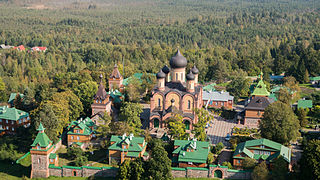
Pühtitsa Convent is a Russian Orthodox convent in Eastern Estonia between Lake Peipus and the Gulf of Finland. A small Orthodox Christian church was built in Pühtitsa in the 16th century. The convent was founded in 1891 and has grown into the largest Orthodox community in the Baltic states.

The Pirita is a 105 km (65 mi) long river in northern Estonia that drains into Tallinn Bay in Pirita, Tallinn. The basin area of the Pirita is 799 km2.

Pirita is one of the eight administrative districts of Tallinn, the capital of Estonia.

Viimne reliikvia is a 1969 Estonian-language Soviet film based on Vürst Gabriel ehk Pirita kloostri viimsed päevad, a historical novel by Eduard Bornhöhe. The film became extremely popular, and some critics consider it the only Estonian cult film.

Kose is a subdistrict of the district of Pirita in Tallinn, the capital of Estonia. It has a population of 3,351.
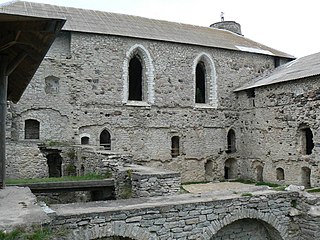
Padise Abbey was a former Cistercian monastery in Padise in Harju County, Estonia, settled in 1310 by the dispossessed monks of Dünamünde Abbey in Latvia. It was converted into a fortress after its dissolution in 1559 and later used as a country house until 1766. The ruins have now been partially restored and made into a museum.

Pelguranna is a subdistrict in the district of Põhja-Tallinn in Tallinn, the capital of Estonia. It is located between Pelgulinn, Kopli and Sitsi and is bordered with the Stroomi Beach by the Kopli Bay to the west, and the Merimets forest park to the south. Houses there mostly consist of 4-9 floor apartment buildings. Pelguranna has a population of 15,142.
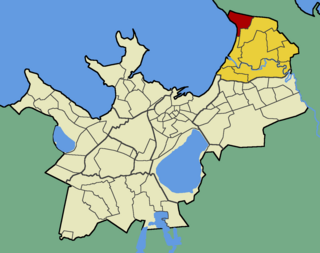
Merivälja is a subdistrict in the district of Pirita, Tallinn, the capital of Estonia. It is located on the eastern coast of the Tallinn Bay, and is the northernmost subdistrict of Tallinn. Merivälja has a population of 3,088. It is the wealthiest subdistrict of the district of Pirita.
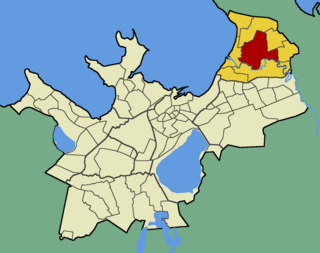
Kloostrimetsa is a subdistrict in the district of Pirita, Tallinn, the capital of Estonia. It's located north of the Pirita River and is mostly covered by the park forest Kloostrimets. Kloostrimetsa has a population of 80.

Pirita is a subdistrict in the district of Pirita, Tallinn, the capital of Estonia. It is located around the estuary of the Pirita River to the Tallinn Bay. The subdistrict has a population of 960. Pirita was selected as the venue of the sailing events for the 1980 summer Olympics. During the preparations for the Olympics, sports buildings were built in Tallinn including the Pirita Yachting Centre and the Hotel Olümpia.

Priisle is a subdistrict in the district of Lasnamäe, Tallinn, the capital of Estonia. It has a population of 10,949.

Muuga is a village in Vinni Parish, Lääne-Viru County, in northeastern Estonia. Between 1992 and 2017 the village was located in Laekvere Parish.

Seli is a village in Rapla Parish, Rapla County in northwestern Estonia.

The Estonian Knighthood House is a building in Toompea, the upper part of Vanalinn, the historic inner town of Tallinn, the capital of Estonia. Its address is Kiriku plats 1. The Dome Church is situated at the same square.

St. Catherine's Dominican Monastery, often simply St. Catherine's Monastery or the Dominican Monastery, is a former monastery and one of the oldest buildings in Tallinn, the capital of Estonia. It is located in the heart of Tallinn's Old Town district full of warehouses and merchants' houses. Its remains constitute one of two remaining medieval monastery complexes in Tallinn.

The Great Guild was a guild for merchants and artisans, operating in Tallinn from at least the 14th century until 1920. It was based in the Great Guild hall, a Gothic building in the historical centre of Tallinn, today housing the Estonian History Museum. In 2013, the Great Guild hall was named a European Heritage site.
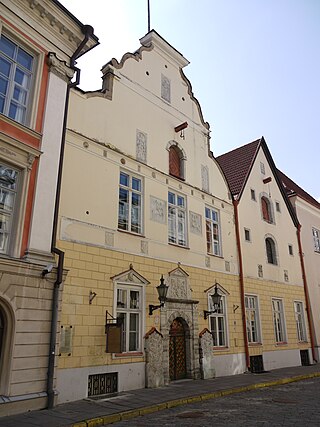
House of the Blackheads, or House of the Brotherhood of Black Heads, in Tallinn, the capital of Estonia, is a former headquarters of the Brotherhood of Blackheads. Historically this was a professional association of ship owners, merchants and foreigners dating from the 14th century. They were active in Livonia but fled to Germany during the Soviet occupation of the Baltic States in 1940. The House of the Blackheads was visited by several Russian Emperors including Peter I, Paul I and Alexander I who also became honorable members the Brotherhood.
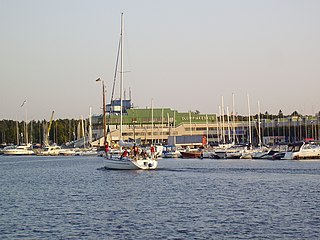
Tallinn Olympic Yachting Centre is a sport complex in Pirita, Tallinn, Estonia.




















